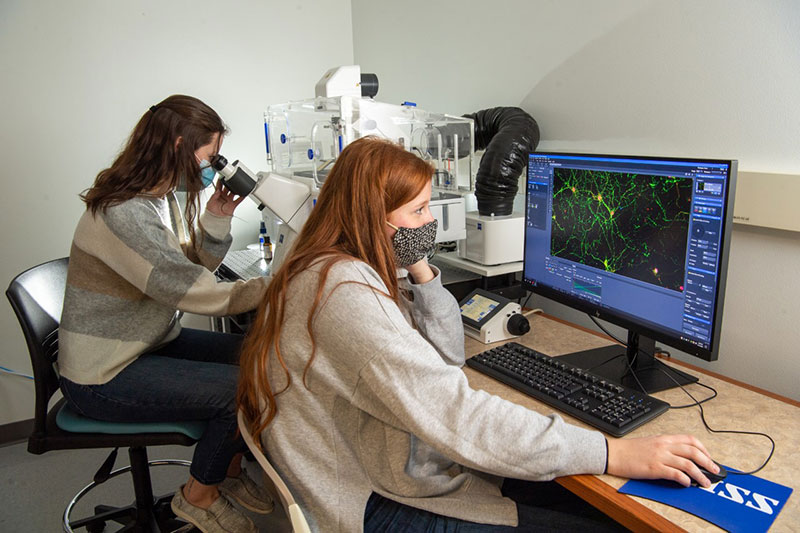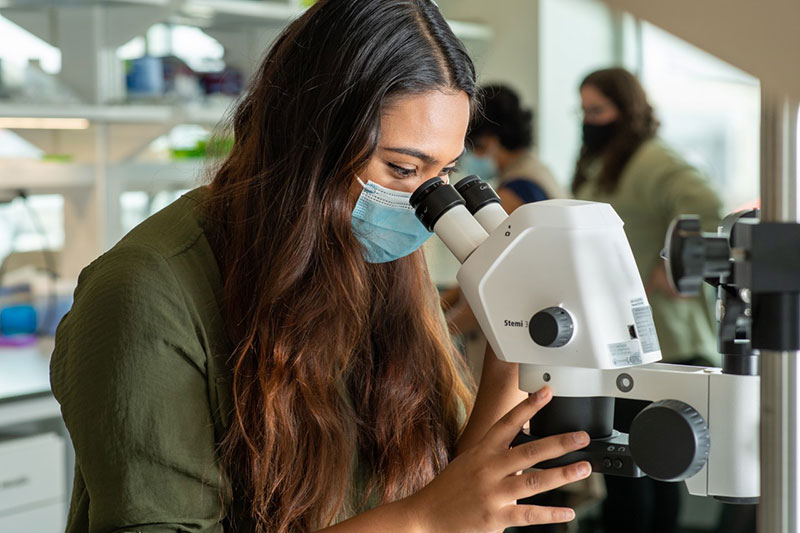Purdue HHS Parkinson research explores exposure risks, effects on speech and swallow
Written by: Tim Brouk
When Allison Schaser joined Purdue University’s College of Health and Human Sciences (HHS) in fall 2020, she brought a unique expertise to a strong Parkinson disease research group. Her perspective — and mouse line — is already playing a vital part in the investigation of this complex disease.
An assistant professor of speech, language and hearing sciences, Schaser focuses her neurological research on the brain’s connection with the muscles used for speech and swallowing. The mouse line offers the opportunity to study living examples — at the molecular level — of why the motor control of speech and swallowing fails in many patients with Parkinson disease.
“We have no way of looking at the underlying structures of Parkinson disease in humans yet,” Schaser said. “That’s why I’ve been interested in moving to an animal model to probe these underlying issues more effectively.”
In the lab, Schaser has concentrated on the brain’s corticobulbar tract — a motor pathway that connects the cerebral cortex to the medullary pyramids area of the brainstem — and cranial sensorimotor control in the brain. The cranial sensorimotor control regions of the brain are critical for speech and swallowing. Schaser uses a visualization microscopy technique where alpha-synuclein proteins, the proteins that build up in the brains of people with Parkinson disease, are tagged with green fluorescence, making protein aggregation visible in mouse brain cells. Her research explores why these proteins misfold and aggregate, setting off a chain reaction that appears to lead to cell death in patients with Parkinson disease. The mouse models allow her to see these reactions in real time.
Losing the ability to easily swallow can be life-threatening. Food can go down the trachea to the lungs as opposed to the esophagus. This could lead to aspiration pneumonia if not controlled, caught or treated in therapy. It can also affect the nutrition of a patient.
“It’s such a natural thing that we all do,” Schaser explained. “It’s not something we think about. Until it goes wrong, most people don’t think they have control over that system or that there are things you can do to change your swallow. When something comes in to change the motor control system of voice and swallow like Parkinson disease, it’s a big shock for these individuals, and it can really affect their quality of life.”

On the voice side of her research, Schaser and her research students must use a specialized soundproof chamber, a microphone and Sonotrack technology to hear the ultrasonic calls of the mice she studies. So far, she has found the mice induced with Parkinson disease “call less frequently.” The calls also appear to be less complex and quieter than healthy mice.
“We can directly correlate those changes in our mouse models with what we are seeing in a human patient as well,” Schaser said. “It helps lead me down the path of trying to understand the control of the neuromuscular system for voice and swallowing and how it changes with aging and neurodegenerative diseases like Parkinson disease.”
Schaser’s ultimate goals are to develop treatments to improve quality of life for patients with Parkinson disease and more awareness of speech and swallowing problems that result from the disease.
“It can affect all aspects of your life,” Schaser said. “You don’t realize that it can until you have a problem. Hopefully we will have a better understanding of how the disease starts, how it progresses, and how we can intervene and stop that progression.”
Exposing Parkinson prevalence
Aaron Bowman, professor and head of the School of Health Sciences, and his lab are investigating toxic environmental factors that elevate risk of Parkinson disease later in life. Focus groups include populations living in rural Indiana areas with heavy pesticide use and populations exposed to mercury or manganese through diet, inhalation and work-related exposures.
“Pesticides and occupational exposures are associated for a risk for Parkinsonism,” Bowman said. “Here in Indiana, our risks for Parkinson disease are increased because so much of our population live and work in rural or near-rural settings in which exposure to these environmental toxicants is prevalent. Many people that live here know someone that has Parkinson disease.”
Bowman’s lab studies Parkinson disease’s attack on neurons located in the substantia nigra — a part of the brain important in reward and movement – that use dopamine, a neurotransmitter within the brain. Bowman uses adult human-induced stem cells to grow neurons in the lab in order to see functional differences in how they respond to different exposures and how our individual genetic differences culminate in either healthy aging or Parkinson disease. The interactions will inform better therapies for people with Parkinson disease.
Who gets Parkinson’s disease and when is another mystery to unravel. Working with HHS-affiliated nursing clinics, Bowman plans to study the genetics of siblings and how they may differ in their responses to environmental factors. Disease affects each person differently, such as two siblings having the same parkin genetic mutation, yet very different disease courses.
“We studied brothers that inherited this mutation from both their parents,” Bowman said. “But one brother showed evidence of his Parkinsonism in his 20s. The other brother, now in his 50s, still doesn’t have Parkinson disease. We are trying to understand the genetic underpinnings for why they would be different.”
Studying environmental exposures and the genetics of people can reveal patterns in who and when Parkinson disease will manifest itself.
“We’re hoping to understand individual risk for the disease,” Bowman said. “Do differences in the genetics between siblings and how they interact with known risk factors factor in why one sibling gets Parkinson disease and the other does not?
“We know a lot about the pathology of the disease and yet don’t understand how to alter that pathology.”
Collaborative approach
Bowman and numerous other HHS faculty members concentrate their Parkinson disease and other neurodegenerative disease research within the Purdue Institute for Integrative Neuroscience (PIIN). Jason Cannon, associate professor in the School of Health Sciences, is the principal investigator for the Grand Challenges in Neuroscience initiative within the Institute. He said the collaborative nature of his HHS colleagues as well as researchers from other Purdue colleges is highly beneficial for the work. Clinical, epidemiological and scientific bases are all covered in these PIIN projects.
“PIIN has brought together different research groups to better attack problems,” Cannon added. “One of those is looking at the role gene-environment interactions have in Parkinson’s disease. We are making some real headway.
“It increases the value of the research when you have a different perspective and different expertise.”
Cannon specializes in how toxicity from chemicals — as well as the food we eat and the water we drink — are linked to neurodegenerative diseases like Parkinson disease. Certain pesticides have been known to seep into well water, putting the drinker in danger of developing Parkinson disease. Since most therapies only put “a Band-Aid” on the symptoms of Parkinson disease, helping at-risk individuals avoid the disease is pivotal.
“The hope is to reduce disease-causing exposures and also tell people with certain genetic make-ups that they need to be especially careful to avoid these types of exposures,” Cannon said.
The work of Cannon and his colleagues is already crucial, but it will become even more so soon.
“The numbers of people with Parkinson disease are expected to dramatically increase as we have an aging population,” he warned. “Parkinson disease and Alzheimer’s disease are increasingly becoming a public health crisis.”
A growing field in the college
There has been a growing interest in studying and researching Parkinson disease from students over the last decade. Bowman counts 11 undergraduates in his lab and many more majoring in health sciences with the goal of studying neurological diseases like Parkinson disease. Cannon and Schaser also have several undergraduate students working with them in their laboratories.
“I hear so many stories from undergraduates and those applying as graduate students of how neurological diseases have impacted their families,” Bowman said. “The students are excited to come to Purdue and know they can get involved in research that relates to their own health and the health of those that they love.”
A junior studying speech, language and hearing sciences, Pranali Suresh was one of Schaser’s first undergraduate lab researchers. The professor’s research focus hooked her in 2020 and continues to do so.

“My grandmother was diagnosed with Parkinson disease a couple years ago and knowing that I get to be part of a research project involving Parkinson disease made me all the more interested,” Suresh said. “This experience has given me the opportunity to increase my clinical and research knowledge, which in turn has and will help tremendously in my professional career.”
Innovative Parkinson’s research is here and will continue to grow. While Schaser hasn’t been in the college a year yet, her work is already gaining momentum. Jessica Huber, professor of speech, language and hearing sciences and HHS associate dean for research, was instantly impressed with Schaser’s focus on Parkinson disease patients’ speech and swallowing at the molecular level.
“Communication and eating, these are really important quality-of-life things,” said Huber of Schaser’s research. “Allison is a pioneer by taking these models of how the alpha-synuclein protein transmits itself to the nervous system and understanding how that changes speech and swallow. “Literally no one else in the world is doing it.”
Discover more from News | College of Health and Human Sciences
Subscribe to get the latest posts sent to your email.